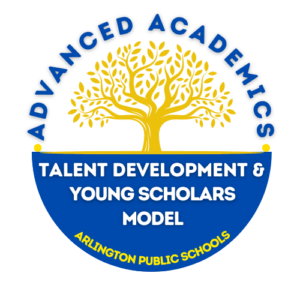
Gifted students need opportunities to think abstractly, work at various rates and levels of complexity, and pursue tasks independently. In addition, students eligible for gifted services need opportunities to learn with others of like abilities, as well as opportunities to develop socio-emotionally. APS Gifted Services are implemented through school-based and countywide activities, which comply with School Board and State objectives. These school-based services are delivered in the following ways:
- APS Gifted Services collaborative resource model, in which the classroom teacher works with the resource teacher for the gifted to develop and present appropriately differentiated learning experiences for gifted students within the general education classroom.
- In the general education classroom setting, identified students are cluster-grouped (minimum of 5 – 8) and through a variety of flexible groupings based on ongoing data.
- Identified students work with teachers who are specifically trained in instructional needs of and curriculum written for gifted students.
- Specific curricula which are differentiated or extended from concepts in the general education curriculum, and when appropriate, through opportunities for acceleration and extension.
The Gifted Cluster Model
The Gifted Cluster model provides services to identified students by allowing the AAC to “push in” to the classroom and collaborate with teachers through CLTs and individual planning sessions. Using this model, GT identified students are placed in Gifted Cluster classrooms with intellectual peers. The classroom teacher, with the support of the AAC, is the primary provider for Gifted Services. Advantages of this model include…
- Students have intellectual peers necessary for academic and social development all day
- Students have more access to gifted curriculum and/or strategies in their classroom
- Non-identified students who also need challenges will have the opportunity to try out advanced curriculum or strategies
- AACs can monitor students that should be assessed for eligibility for gifted services
AAC Roles and Responsibilities
- Collaborate and co-plan with teachers
- Extend and deepen student learning through higher level discussion, rich content, and high expectations
- Provide supplemental resources
- Model lessons, co-instruct, or facilitate lessons
- Coaching best practices instructional strategies (i.e. APS’ K-12 Critical Thinking Strategies)
- Facilitate book clubs and extension projects
- Promote differentiation practices throughout the school
- Manage gifted and talented screening process and evaluation
- Facilitate professional development for teachers
For more information about Arlington Public Schools’ full plan for Gifted Services, please review: https://www.apsva.us/gifted-services/. For frequently asked questions, please review: https://www.apsva.us/gifted-services/frequently-asked-questions-faq/. If you have school-specific questions, or if you would like to learn more about differentiation, growth mindset practices, and gifted services in our building, please do not hesitate to contact me directly at [email protected].
Classroom Teacher’s Role and Responsibilities
- Collaborate with the AAC to provide differentiated curriculum, extension opportunities, and supplemental curriculum resources
- Plan units and lessons to meet the learning needs of students eligible for gifted services
- Coordinate instructional needs of all learners in the classroom
- Keep open communication with AAC on students that may need to be screened for gifted services
 Contact
Contact  Calendars
Calendars Careers
Careers Engage
Engage  District
District
